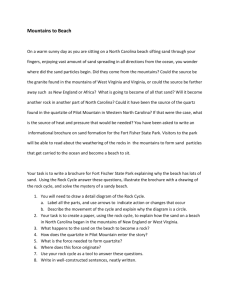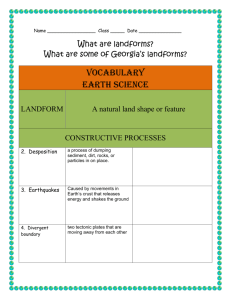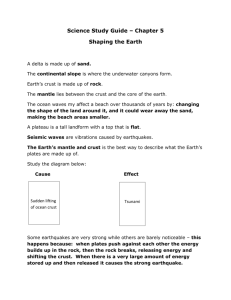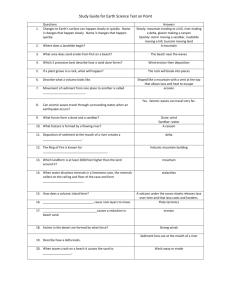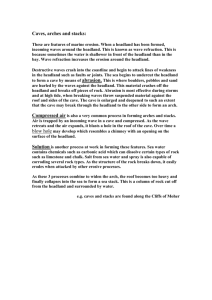The work of the Sea - Finn Valley College
advertisement
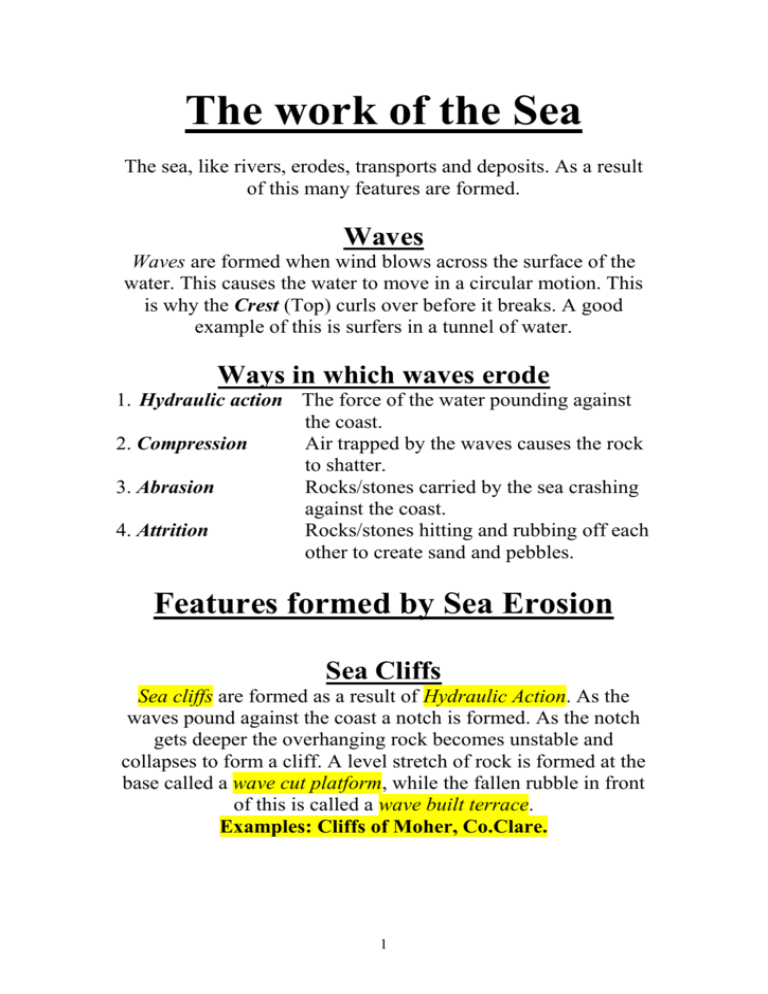
The work of the Sea The sea, like rivers, erodes, transports and deposits. As a result of this many features are formed. Waves Waves are formed when wind blows across the surface of the water. This causes the water to move in a circular motion. This is why the Crest (Top) curls over before it breaks. A good example of this is surfers in a tunnel of water. Ways in which waves erode 1. Hydraulic action The force of the water pounding against the coast. 2. Compression Air trapped by the waves causes the rock to shatter. 3. Abrasion Rocks/stones carried by the sea crashing against the coast. 4. Attrition Rocks/stones hitting and rubbing off each other to create sand and pebbles. Features formed by Sea Erosion Sea Cliffs Sea cliffs are formed as a result of Hydraulic Action. As the waves pound against the coast a notch is formed. As the notch gets deeper the overhanging rock becomes unstable and collapses to form a cliff. A level stretch of rock is formed at the base called a wave cut platform, while the fallen rubble in front of this is called a wave built terrace. Examples: Cliffs of Moher, Co.Clare. 1 Bays A Bay is a wide, curved opening into the coast. It is formed where areas of hard rock and soft rock lie side by side. The soft rock erodes faster to form a bay shape. Sandy beaches are often found on the inside of bays. Example: Donegal Bay. Headlands A Headland is formed in the same way as a bay only that it is the hard, resistant rock that is left behind that makes up the headland. A piece of land that juts further out into the sea than the land around it is a headland. Example: Malin Head, Co.Donegal. Sea Caves A Sea Cave is a long tunnel shape on a Sea Cliff. It gets lower and narrower the further into the cliff it goes. Waves find a weak spot at the base of the cliff and gradually erodes it until a cave is formed. Example: Bundoran, Co. Donegal. Sea Arch A Sea Arch is an arch-shaped tunnel through a headland. It is formed as a result of a cave eroding right through to the other side of a (narrow) headland. Example: Bundoran, Co.Donegal. Sea Stack A Sea Stack is a pillar of rock that stands alone just off the coast. It is formed when the roof of a Sea Arch collapses into the sea. The Sea Stack is totally surrounded by water. On an ordnance survey map they are always found just off the coast and are referred to as ‘rocks’. A sea stump is a worn down stack. Example: Bundoran, Co. Donegal. 2 Blowholes A Blowhole is a hole on the mainland that forms above a Sea Cave. It is formed by Compression. Air gets trapped in a cave by waves and causes small rock particles to shatter. Over a period of time the roof will eventually break through to the surface and form a blowhole. It is called a blowhole as water often sprays up out of it. Example: ‘McSweeney’s Gun’, Co.Donegal. Transport by the Sea Waves carry the seas’ load in two ways/directions. Up and down the shore by the Swash and Backswash. Along the shore by Longshore Drift. Waves approach the coast at an acute angle (roughly 45). As a result of this the material that has been deposited on a beach is constantly being moved across to one side (in a zig-zag pattern). This results in a build up of sand at one end of the beach. Deposition occurs mainly in sheltered areas like bays and areas of shallow water. The lighter material (sand) is found closer to the sea while the shingle (sand and pebbles) are found further up the beach and would have been deposited during storms, hence the name Storm Beach. 3 Features formed by Sea Deposition Beaches Beaches are formed when waves that are carrying sand/pebbles break when they reach the shore. When they break they lose their power and so drop whatever they were carrying. Beaches are usually found on the inside of bays. The material is usually sorted in layers. Heavier material found further up the beach and sand found closer to the waters edge. On an ordnance survey map beaches appear as yellow. Sand Dunes Sand dunes are formed when sea breezes blow the dry sand off a beach and on to the land behind it. After some time the sand accumulates to form sand dunes. Marram grass helps to bind the dunes together. Sand Spit A sand spit is a narrow ridge of sand that juts out into the sea but is connected to the land at one end. It is formed as a result of a beach extending out into a bay. The sand which had been carried by Longshore Drift eventually builds up to form a sand spit. Example: Portmarnock, Co.Dublin. Sand Bar A Sand Bar is a beach or sand spit that stretches right across a bay and seals part of it off from the rest of the bay. The trapped water that has been cut off is now referred to as a Lagoon. Example: Lady’s Island Lake, Co.Wexford. 4 Tombolos A Tombolo is a narrow ridge of material that joins an offshore island to the mainland. Example: Howth, in Co.Dublin used to be an island until a tombolo joined it to the mainland. People and the Sea Ways in which the sea helps people 1. 2. 3. 4. Useful for tourism and leisure activities. Provide fish for food etc. The sea floor provides a lot of fossil fuels.Oil,Gas,Coal etc Wave power. Provides electricity. Ways in which the sea harms people 1. Land and property may be lost due to Erosion. 2. Low lying areas may become flooded. E.g. Holland, Bangladesh. 3. May increase the damage caused by pollution i.e. Waves/currents spreading oil spills over vast distances. Ways of defending against the Sea Strong concrete Sea Walls or large boulders to break waves and reduce erosion. Breakwaters to reduce erosion in the area sheltered by it. Groynes (Concrete or Wooden) to reduce Longshore Drift. Dredge harbours to get rid of sand deposited as a result of Longshore Drift. 5 6

